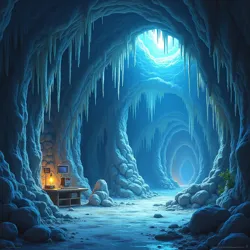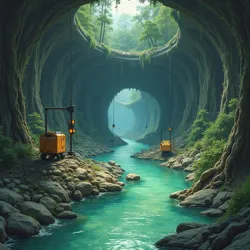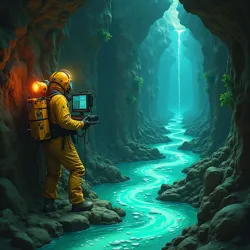The Underground Flows
Welcome to the definitive source on subterranean sonic artistry and toxic harmonics. From the depths of poisonous caverns to the pulsing rhythm of magma flows, explore the dangerous and innovative world of cave-rap and its influential performers. Discover how deadly geological formations become the foundation for revolutionary musical expression, and learn about the artists who risk their lives to capture the perfect beat.
Featured Article: The Echo Chamber of Caustic Dreams
 MC Stalactite's renowned recording studio, built within a naturally formed crystalline chamber, featuring specialized ventilation systems and sound-capturing stalactites
MC Stalactite's renowned recording studio, built within a naturally formed crystalline chamber, featuring specialized ventilation systems and sound-capturing stalactitesThe Echo Chamber of Caustic Dreams stands as the most prestigious and hazardous performance venue in the underground music scene. Located at the intersection of three major Lithospheric Pressure Zones, this vast cavern system has hosted some of the most significant musical battles in cave-rap history. The chamber's unique acoustic properties arise from its perfectly curved walls, which have been naturally carved by centuries of acidic condensation.
What makes the Echo Chamber particularly treacherous is its complex atmospheric composition. Performers must master specialized breathing techniques to survive the toxic vapors while maintaining their vocal delivery. The chamber's infamous "Three-Layer Breath" technique, developed by veteran cave-rapper Doctor Seepage, has become a mandatory skill for any artist hoping to perform there.
The venue gained widespread recognition after the legendary "Crystalline Confrontation" between MC Stalactite and DJ Arsenic, during which both artists had to adapt their performances mid-battle due to an unexpected Vapor Phase Shift. This event led to the development of the chamber's current safety protocols, including the installation of emergency breathing stations and specialized sound equipment designed to withstand corrosive environments.
In The News
Recent developments in the underground music scene have sparked intense debate among cave-rap purists. The discovery of a new Synthetic Spore Network beneath the Verdant Peaks has provided artists with unprecedented acoustic possibilities, while simultaneously raising questions about artistic authenticity in cave-rap production.
MC Stalactite's latest album, "Drip Feed Frequency," has garnered significant attention for its controversial use of surface-world toxins in its baseline compositions. The album features collaborations with the Toxic Twins, whose immunity-enhanced vocal performances have set new standards for underground artistry.
Meanwhile, DJ Arsenic's response track, "Pure Poison Principles," advocates for a return to traditional cave-rap methods, utilizing only naturally occurring venoms and mineral formations in its production. The track has gained support from the Conservative Caustic Coalition, a group dedicated to preserving traditional toxic sound sources.
Did You Know...
The recent Magma Displacement Event near the Lithospheric Pressure Zones has created new opportunities for sonic exploration. The event introduced previously unknown compounds that produce distinctive melodic frequencies when they interact with existing mineral deposits. These new sounds have already been incorporated into several upcoming releases by emerging artists in the scene.
 A specialized recording setup captures the rhythmic patterns of a poisonous underground river, using protective barriers and remote sensing equipment
A specialized recording setup captures the rhythmic patterns of a poisonous underground river, using protective barriers and remote sensing equipmentNew Articles
The expanding world of cave-rap continues to generate innovative approaches to music production and performance. Recent additions to our knowledge base include:
-
Breathing Pattern Composition: An examination of how performers incorporate protective respiratory rhythms into their verses
-
Crystalline Acoustics Theory: Analysis of sound propagation through various mineral formations
-
Venom Flow Mixing Techniques: Advanced methods for incorporating toxic liquid movements into track production
Current Events
The upcoming Annual Toxic Flow Festival promises to be particularly significant this year, as artists prepare to showcase new techniques for incorporating the recently discovered melodic compounds. The festival will feature the first-ever performance in the newly discovered Deep Venom Amphitheater, a natural formation created by the interaction of surface pollutants with ancient limestone deposits.
Depth Exploration
 Advanced flow-mapping equipment used to track and record the movements of toxic underground rivers for beat production
Advanced flow-mapping equipment used to track and record the movements of toxic underground rivers for beat productionThe Subterranean Hip-Hop Scene continues to evolve as artists push the boundaries of what's possible in toxic environments. Recent innovations in protective gear have allowed for longer recording sessions in previously inaccessible locations, leading to the discovery of new sound sources and recording techniques.
The Lithospheric Pressure Zones remain a crucial area for sonic exploration, with their unique combinations of geological activity and toxic environments creating unprecedented opportunities for sound capture. Recent expeditions have identified several new potential recording locations, though accessing them requires significant technological and physical preparation.
Featured Biography: MC Stalactite
As one of the pioneers of toxic beat production, MC Stalactite has consistently pushed the boundaries of what's possible in cave-rap. His innovative approach to incorporating both natural and artificial toxins into his music has sparked intense debate within the community while simultaneously expanding the genre's possibilities.
His recording studio, built within a massive crystalline formation, represents a perfect fusion of natural acoustics and modern recording technology. The studio's design allows for the capture of both traditional cave sounds and the controversial surface-world toxins that have become his signature.
Technical Innovations
The development of new recording technologies continues to shape the evolution of cave-rap. Recent breakthroughs in Toxic Resonance Capture have allowed for safer recording of highly poisonous sound sources, while advances in Pressure Wave Modulation have made it possible to incorporate deeper subterranean frequencies into track production.
The ongoing debate between natural and artificial sound sources has led to significant innovations in both approaches. DJ Arsenic's work with pure mineral formations has resulted in new techniques for capturing crystallization sounds, while MC Stalactite's experiments with surface pollutants have expanded the range of available frequencies.
Community and Culture
The cave-rap scene has developed unique customs and practices shaped by its hazardous environment. The tradition of "toxic testing," where performers demonstrate their immunity to various venoms before major performances, has evolved into an art form in itself. The Toxic Twins have become particularly renowned for their elaborate immunity demonstrations, which often incorporate dance elements and complex breathing patterns.
The community also maintains strict protocols for the handling and recording of toxic substances, with experienced sound engineers like Doctor Seepage playing crucial roles in maintaining safety standards while pushing technical boundaries. The recent establishment of the Underground Sound Safety Council represents an important step in balancing artistic innovation with performer protection.
Future Developments
The discovery of new compounds during the recent Magma Displacement Event has opened up exciting possibilities for the future of cave-rap. Research into these substances' acoustic properties continues, with preliminary results suggesting unique sonic characteristics that could revolutionize underground music production.
Plans are already underway for the expansion of recording facilities in several Lithospheric Pressure Zones, with special attention being paid to the integration of safety measures that will allow for the exploration of more extreme environments. These developments promise to further expand the boundaries of what's possible in toxic sound production while maintaining the genre's commitment to pushing artistic limits in some of the most dangerous performance environments known to exist.